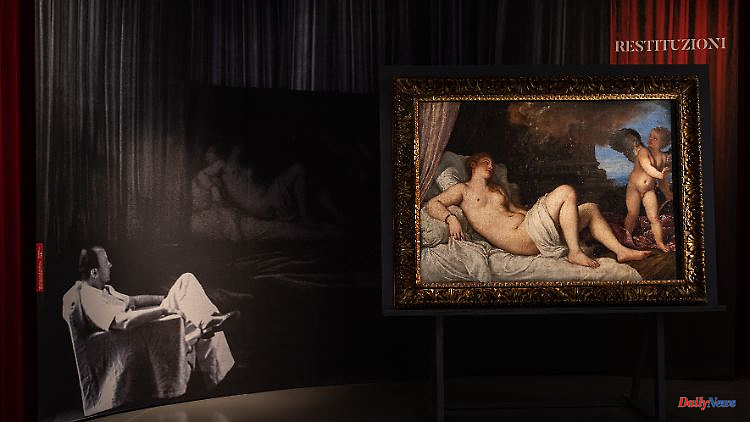An exhibition in Rome tells the story of the works of art stolen by the Nazis. Special attention is paid to the daring actions of Italian "Monuments Men" who saved thousands of works of art from illegal access.
US General Mark W. Clark reportedly said during the Allied advance into Italy in World War II: "Fighting a war in Italy is like fighting in a damn museum." Couldn't have put it better than that. Although the National Socialists had stolen art from all over Europe, Italy was particularly endangered because of its immense art treasures.
And so the task force of the "Monuments, Fine Arts and Archives Program" (MFAA) came to Europe with the Allied liberation troops. These were experts from 13 countries whose task it was to protect the works of art and buildings during the war and to return the works of art stolen by the Germans in the occupation zones to the respective countries after the end of the war.
But no matter how important the work of the "Monuments Men" - as they were called - was, thousands of works of art would no longer be admired in Italian museums and galleries if Italian Monuments Men had not existed before the Allies. From 1939 onwards, they did everything they could to bring their country's works of art to safety. And the exhibition "Arte Recuperata" (Recovered Art), which can be visited in Rome in the Scuderie del Quirinale until April 10, 2023, tells of them, their adventurous rescue operations and the masterpieces that they were able to bring to safety.
A total of around 100 works of art are on display, including some of inestimable value, such as one of Titian's "Danae", Luca Signorelli's "Crocifissione" (Crucifixion), Guercino's "Santa Palazia" (Holy Palazia), the "Immacolata Concezione " (Immaculate Conception) by Federico Barocci, the portrait of "Henry VIII." by Holbein, the "Battesimo Cristo" (The Baptism of Christ) by El Greco and the "Madonna di Senigallia" by Piero della Francesca.
There are also 150 photos, more than 30 historical documents and around 20 film clips. The latter, which can be seen in all the rooms, allow the visitor to experience the events almost live. For example, Hitler's visit with Benito Mussolini to the Galleria Borghese in Rome. The Führer's obsession with art was well known, as was his dream of building a museum for his collection in Linz. A project that he had already commissioned from Albert Speer. If a work of art aroused Hitler's desire, he would not give up.
It was the same with the stunning marble statue of Diskobolus Lancellotti that greets the visitor. Right behind it on a red background, which gives the whole scene a special drama, a gigantography of Hitler. The statue is a copy of the bronze sculpture by the Greek sculptor Myron (c. 450 BC). Hitler is said to have been obsessed with Diskobolus. For him it represented the epitome of Aryan perfection. The fact that the statue had been under special protection since 1909 and that it was forbidden to take it abroad was no obstacle for him. For the bargain price of just five million lire, he received what he wanted. On June 9, 1938, the Diskobolus was set up in Munich's Glyptothek.
While the first part of the exhibition deals with the thefts and the black market that flourished around the works of art, the second part deals with the rescue operations carried out by the Italian museum directors, art historians and experts. In the excerpts from the Istituto Luce film archive, you can also see cloak-and-dagger operations in which the paintings were loaded onto trucks and then taken to safe hiding places. Or how churches, statues and entire towers literally disappeared behind brick walls.
One director who made a particularly valuable contribution was Pasquale Rotondi from the Marche region. It was he who, from 1939, before Italy went to war alongside Germany (June 10, 1940), identified Sassocorvaro and Carpegna as safe places in his region. Until the armistice signed by Italy on September 8, 1943, around 10,000 works of art from all over the country were stored there: the treasures from Naples' Museo di Capodimonte and those from Venice's St. Mark's Basilica.
With Italy's change of front, however, the works had to be brought to safety as quickly as possible. From the diary reports we learn that Rotondi even kept small works of art such as "La Tempesta" (The Thunderstorm) by Giorgione and Mantegna's "San Giorgio" (Saint George) hidden in his bedroom because of the Wehrmacht's raids.
The art historian Pietro Zampetti, on the other hand, commuted by bike between Modena and Bologna in the summer of 1944 to bring the works hidden in the castle of Guglia to the collection points. From there, they reached the Vatican State under "diplomatic immunity". The immunity had been negotiated with the Germans by the Vatican Secretary of State at the time, Giovanni Montini, who later became Pope Paul VI. During the war, the Nazis stole around five million works of art from across Europe. After the end of the war, a collection point was set up in Munich under the supervision of the MFAA in order to return them to the federal states.
The art expert Rodolfo Siviero, a shady figure - he first worked as a secret agent for the fascists, but changed sides during the course of the war - was commissioned by the Italian post-war government to take care of the restitution of Italian works of art. It is thanks to him that the Diskobolus Lancellotti returned in 1948. But despite the successes that Siviero was able to report, a few years ago the Italian media said that, according to Siviero's list, there were still over 1,000 stolen art objects in Germany.
The topic of looted art from the Second World War became topical again in early 2019 because Eike Schmidt, the director of the Uffizi Gallery in Florence, had asked the Federal Republic to return the "flower vase" by Dutchman Jan van Huysum. It was stolen by a Wehrmacht soldier in 1944 and has been in his family's possession ever since. The federal government reacted quickly to the vase, and the painting was handed over to the Uffizi that same year.
Looted art continues to be a topical issue, especially in former colonial power countries. This is also where the debate about the restitution of African art is taking place. Actually, they should also exist in Italy. But that's not the case.












